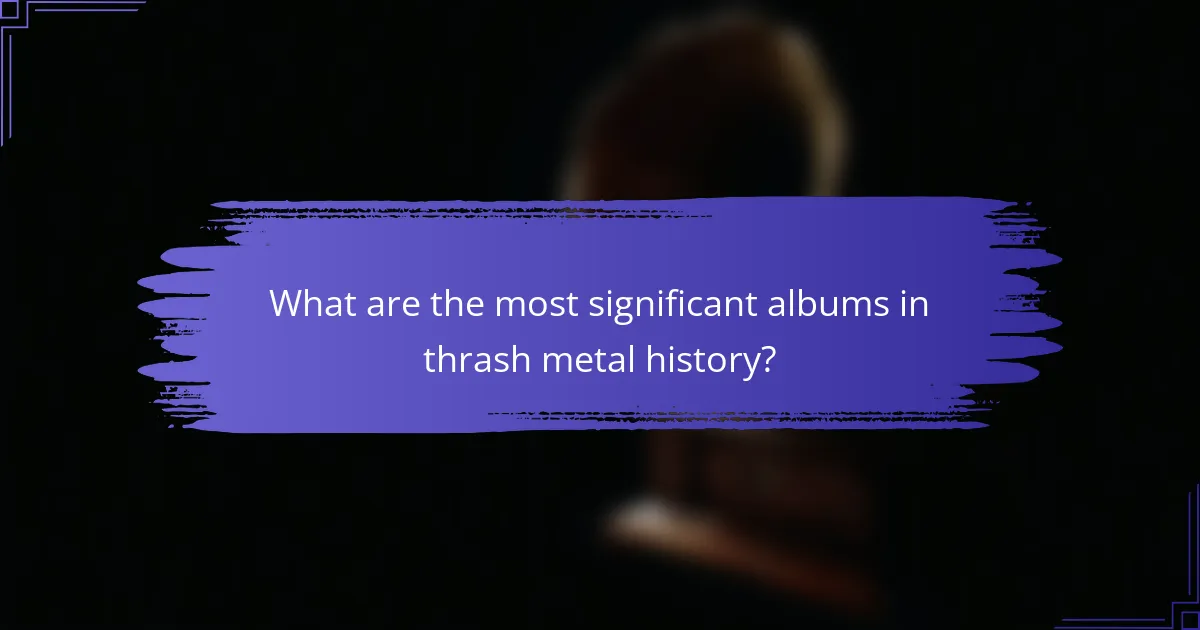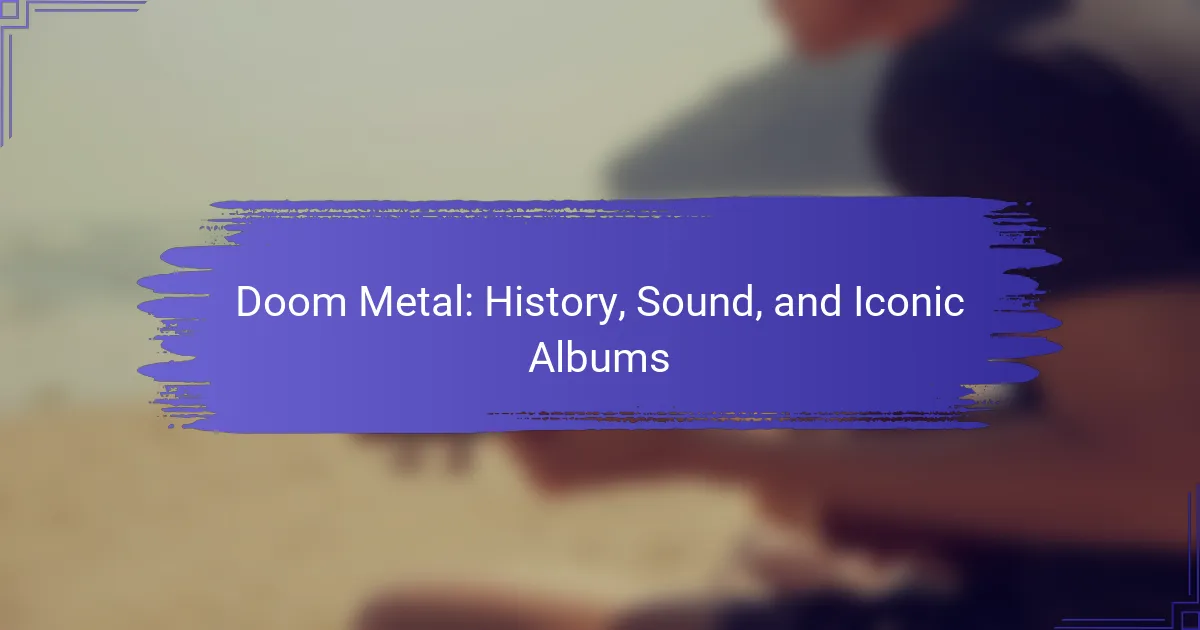Thrash metal has left an indelible mark on the music landscape, characterised by its speed, aggression, and complex structures. This article explores influential bands like Metallica and Slayer, key albums such as “Master of Puppets” and “Reign in Blood,” and the genre’s cultural impact on movements like punk rock and skate culture. Additionally, it examines the evolution of thrash metal and its future trends, highlighting its enduring legacy.

Which bands defined the thrash metal genre?
Metallica, Slayer, Megadeth, and Anthrax defined the thrash metal genre. These bands shaped its sound and cultural significance from the 1980s onwards.
Metallica’s “Master of Puppets” showcased intricate guitar work and complex song structures. Slayer’s “Reign in Blood” pushed the boundaries of speed and aggression. Megadeth’s “Rust in Peace” displayed technical proficiency and lyrical depth. Anthrax’s “Among the Living” blended thrash with punk influences, broadening the genre’s appeal.
These bands collectively influenced countless musicians and contributed to the evolution of heavy metal. Their legacy continues to resonate in contemporary music, highlighting thrash metal’s enduring impact on the metal scene.
What are the key characteristics of influential thrash metal bands?
Influential thrash metal bands are characterised by aggressive guitar riffs, fast tempos, socially conscious lyrics, and a DIY ethic. Key bands include Metallica, Slayer, Megadeth, and Anthrax, each contributing unique sounds and styles. Metallica’s “Master of Puppets” showcases complex arrangements, while Slayer’s “Reign in Blood” set a standard for speed and intensity. Megadeth’s technical proficiency and Anthrax’s fusion of punk elements further define the genre. These bands not only shaped thrash metal but also influenced broader metal culture and musical trends.
How did regional scenes shape thrash metal bands?
Regional scenes significantly influenced thrash metal bands by shaping their sound and identity. Local music cultures provided a unique backdrop that inspired lyrical themes and musical styles. For instance, the Bay Area scene fostered bands like Metallica and Slayer, emphasising speed and aggression. In contrast, the German thrash scene, with bands such as Kreator and Sodom, introduced a more melodic yet aggressive approach.
Geographical distinctions also led to variations in instrumentation and production techniques. The California scene favoured a polished sound, while European bands often embraced rawer, more underground aesthetics. This diversity contributed to the genre’s evolution, showcasing how regional characteristics can create distinct sub-styles within a broader musical movement.
Moreover, local venues and festivals played a crucial role in promoting thrash metal, allowing bands to connect with audiences and other musicians. These interactions fostered collaboration and competition, driving innovation in the genre. Thus, regional scenes not only shaped the music but also the community around thrash metal, influencing its cultural impact and longevity.

What are the most significant albums in thrash metal history?
The most significant albums in thrash metal history include “Master of Puppets” by Metallica, “Reign in Blood” by Slayer, and “Rust in Peace” by Megadeth. These albums defined the genre’s sound and cultural impact.
“Master of Puppets” (1986) showcased complex song structures and lyrical depth, influencing countless bands. “Reign in Blood” (1986) is noted for its speed and aggression, setting a benchmark for thrash metal. “Rust in Peace” (1990) introduced technical precision, solidifying Megadeth’s place in the genre.
Other notable albums include “Among the Living” by Anthrax and “The Legacy” by Testament, both contributing unique attributes to the thrash metal landscape. These albums collectively shaped the genre’s evolution and cultural significance.
Which albums are considered essential listening for thrash metal fans?
Essential listening for thrash metal fans includes albums that define the genre. Key albums are “Master of Puppets” by Metallica, “Reign in Blood” by Slayer, “Rust in Peace” by Megadeth, and “Among the Living” by Anthrax. These albums showcase the technical skill and aggression that characterise thrash metal. Each has significantly influenced the genre’s development and cultural impact.
How do album releases reflect the evolution of thrash metal?
Album releases highlight thrash metal’s evolution through changing musical styles, lyrical themes, and production techniques. Early albums like Metallica’s “Kill ‘Em All” set the foundation with aggressive riffs and fast tempos. As the genre progressed, bands like Slayer and Megadeth introduced more complex arrangements and darker lyrical content, reflecting societal issues. The 1990s saw a shift with albums incorporating elements from other genres, showcasing thrash metal’s adaptability. Overall, album releases serve as milestones, documenting the genre’s growth and cultural impact over time.

How did thrash metal influence other music genres?
Thrash metal significantly influenced various music genres by introducing faster tempos, aggressive guitar riffs, and complex song structures. Bands like Metallica and Slayer inspired punk rock and alternative metal, while elements of thrash can be found in genres such as nu-metal and metalcore. Key albums like “Master of Puppets” and “Reign in Blood” set new standards for intensity and technical proficiency. This cultural impact reshaped the music landscape, fostering a generation of musicians who embraced its raw energy and rebellious spirit.
What crossover elements exist between thrash metal and punk rock?
Thrash metal and punk rock share elements like aggressive tempos, raw energy, and anti-establishment themes. Influential bands such as Metallica and Slayer draw from punk’s fast rhythms and DIY ethos. Key albums, including “Kill ‘Em All” and “Never Mind the Bollocks,” showcase this crossover. Both genres emphasise rebellion, making them culturally significant in shaping alternative music scenes.
How has thrash metal impacted modern metal subgenres?
Thrash metal has significantly shaped modern metal subgenres by introducing speed, aggression, and complex rhythms. Influential bands like Metallica and Slayer pioneered techniques that inspired genres such as metalcore and death metal. Key albums, including Metallica’s “Master of Puppets,” set benchmarks for production and songwriting. The cultural impact of thrash metal is evident in its promotion of DIY ethics and underground scenes, fostering a community that values authenticity and musical prowess.

What cultural movements were influenced by thrash metal?
Thrash metal significantly influenced various cultural movements, including punk rock and skate culture. Bands like Metallica and Slayer shaped the sound and attitude of these movements, promoting a DIY ethos and rebellion against mainstream norms. Key albums, such as “Master of Puppets” and “Reign in Blood,” became anthems for youth disillusionment and empowerment, fostering a sense of community among fans. Additionally, the aggressive music style and lyrical themes resonated with the anti-establishment sentiments of the 1980s and 1990s, impacting fashion, art, and social activism within these cultures.
How did thrash metal intersect with social and political issues?
Thrash metal intersected with social and political issues by addressing themes like war, inequality, and government corruption. Bands like Metallica and Slayer used their lyrics to critique societal norms and injustices. Their music resonated with audiences facing economic hardship and political unrest, particularly in the 1980s. This genre became a voice for disillusioned youth, reflecting their frustrations and anger. The aggressive sound and powerful messages galvanised fans, making thrash metal a significant cultural force that challenged the status quo.
What role did thrash metal play in youth culture during the 1980s and 1990s?
Thrash metal significantly shaped youth culture in the 1980s and 1990s by providing a voice for rebellion and social issues. Bands like Metallica and Slayer addressed themes of alienation, war, and injustice, resonating deeply with young audiences. Key albums such as “Master of Puppets” and “Reign in Blood” became anthems for a generation, influencing fashion, attitudes, and music styles. The genre fostered a sense of community through concerts and fan interactions, promoting a distinct subculture characterised by its aggressive sound and DIY ethos. As a result, thrash metal left a lasting impact on both music and youth identity during this era.

Which thrash metal festivals and events are significant today?
Significant thrash metal festivals today include the Maryland Deathfest, Thrash Bash, and the Bang Your Head!!! Festival. These events celebrate thrash metal’s legacy and showcase both established and emerging bands. Maryland Deathfest, held annually in Baltimore, features a diverse lineup and attracts fans globally. Thrash Bash focuses on the genre’s roots, offering a more intimate setting. Bang Your Head!!! Festival in Germany highlights classic acts alongside modern thrash bands, reinforcing the genre’s cultural impact.
What are the key thrash metal festivals around the world?
Key thrash metal festivals around the world include the Big Four Festival, Wacken Open Air, and Download Festival. These events showcase influential bands and celebrate the genre’s cultural impact.
1. Big Four Festival: Features Metallica, Slayer, Megadeth, and Anthrax, highlighting thrash metal’s legacy.
2. Wacken Open Air: Germany’s largest metal festival, hosting a diverse lineup with thrash metal prominence.
3. Download Festival: UK festival known for its heavy metal focus, often featuring thrash acts.
4. Hellfest: French festival celebrated for its extensive lineup, including major thrash metal bands.
5. Summer Breeze: German festival featuring a mix of metal genres, including thrash metal acts.
6. Bloodstock Open Air: UK festival dedicated to heavy metal, showcasing thrash metal performances.
How do these events foster community among thrash metal fans?
Thrash metal events foster community by uniting fans through shared experiences and mutual appreciation. These gatherings create a space for fans to connect over their passion for influential bands and key albums.
Concerts and festivals encourage camaraderie, as fans bond over live performances and the energy of the crowd. Merchandise exchanges and discussions about cultural impact further solidify these connections.
Local shows often feature underground bands, enhancing community ties and supporting the genre’s growth. This grassroots involvement fosters loyalty and a sense of belonging among thrash metal enthusiasts.
Social media platforms amplify these connections, allowing fans to share experiences, discuss music, and promote events. This virtual engagement complements in-person interactions, creating a robust thrash metal community.

What are the future trends for thrash metal music?
Thrash metal music is expected to evolve with a blend of traditional elements and modern influences. Key trends include the integration of technology in music production, a resurgence of vinyl, and a growing emphasis on live performances.
The genre may see collaborations with artists from other genres, enhancing its reach. Additionally, themes addressing social issues are likely to gain prominence, reflecting the changing cultural landscape.
Innovative marketing strategies through social media platforms will further connect bands with audiences. Thrash metal’s core attributes, such as speed and aggression, will remain, but the incorporation of unique sounds may attract new fans.
As a result, thrash metal is poised for a dynamic future, balancing its roots with contemporary trends.
How are new bands innovating within the thrash metal genre?
New bands are innovating thrash metal by blending diverse musical styles and incorporating modern technology. They experiment with elements from genres like hardcore punk and progressive metal, creating unique sounds. Bands such as Power Trip and Havok are notable for their fresh approaches, often emphasising lyrical themes that address contemporary issues. Additionally, advancements in production techniques allow for clearer and more dynamic soundscapes, enhancing the overall listening experience. This evolution keeps thrash metal relevant and engaging for new audiences while honouring its roots.
What challenges do thrash metal bands face in the current music industry?
Thrash metal bands face significant challenges in the current music industry, including market saturation, declining album sales, and evolving listener preferences. The genre struggles to maintain visibility amid mainstream trends and competition from digital platforms. Additionally, many bands encounter difficulties in securing tours and promotions due to budget constraints and the impact of streaming services on revenue. The need for constant innovation and adaptation to new technologies further complicates their efforts to connect with audiences.
What best practices can emerging thrash metal bands adopt for success?
Emerging thrash metal bands should focus on authenticity, strong live performances, and building a dedicated fanbase. Establish a unique sound while honouring thrash metal roots. Collaborate with established artists for exposure and leverage social media for engagement.
1. Develop a distinct musical style that blends aggression and melody.
2. Engage actively with fans through social media platforms.
3. Perform regularly to hone live skills and attract new listeners.
4. Network with other bands and industry professionals for opportunities.
5. Release high-quality recordings that showcase musicianship and production value.



